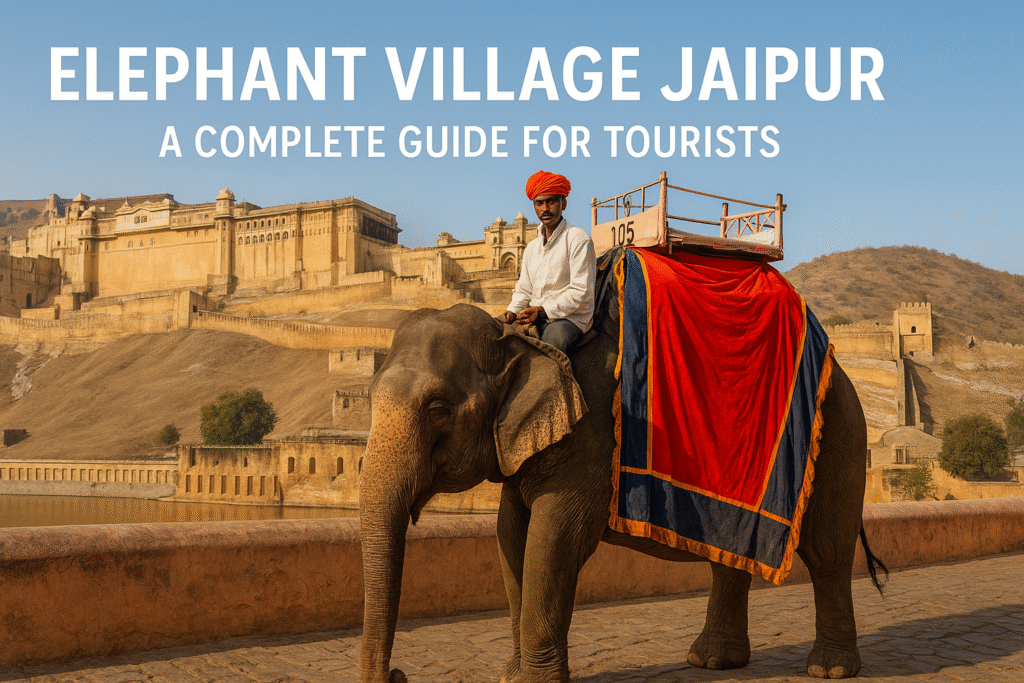Elephant Village Jaipur – A Complete Guide for Tourists

Looking to do something offbeat in Jaipur beyond palaces and forts? Elephant Village, locally known as Hathi Gaon, offers a rare and heartwarming experience where you can spend time with elephants in a peaceful, rural setting.
Instead of watching them from a distance or riding on their backs, this place allows visitors to interact with elephants more naturally — by feeding them, walking alongside them, or even giving them a bath.
But before you plan your visit, it’s important to understand what Elephant Village actually is, how ethical it is, and what you should expect from this experience. This blog will guide you through everything you need to know before visiting Elephant Village Jaipur.
Elephant Village Jaipur?
Elephant Village (Hathi Gaon) is a designated area on the outskirts of Jaipur, developed by the Rajasthan government. It serves as a residential area for mahouts (elephant caretakers) and their elephants.
The idea behind this village was to provide proper shelter, medical care, and natural surroundings for elephants who have traditionally been part of festivals, weddings, and tourism in Rajasthan.
Elephants have also played a major role in local celebrations — you can read more about their cultural connection in our guide on Local Festivals in Jaipur.
Location and How to Reach
Elephant Village is located near Amer Fort, one of Jaipur’s major tourist attractions.
Distance from popular spots:
11 km from Jaipur Railway Station
2 km from Amer Fort
13 km from Hawa Mahal
How to reach:
You can reach the village by auto, cab, or as part of a pre-booked local tour. Public transport is limited, so it’s best to hire a private taxi or driver.
If you’re planning a tight schedule, see how you can include Hathi Gaon in a One Day Jaipur Itinerary without missing key attractions.
What to Expect at Elephant Village
Unlike elephant camps that offer rides, Hathi Gaon focuses more on interaction and care. Visitors can:
Feed elephants with bananas or sugarcane
Walk alongside them through the village
Give them a bath in small ponds during summer
Observe daily routines like grooming and feeding
Ask questions to the mahouts and learn about their lives
Most of the activities are done under supervision. The goal is to ensure that visitors enjoy the experience without disturbing the natural behavior of the animals.
Is It Ethical to Visit?
This is a common concern, especially for animal lovers. In the past, elephant rides in Jaipur (especially at Amer Fort) have received criticism due to poor treatment of the animals.
Elephant Village is a step towards more conscious tourism. While not all operators are perfect, many are now shifting towards non-riding, experience-based interactions.
If you’re planning to visit:
Avoid places that push elephant rides
Choose experiences that focus on care, not performance
Watch how elephants are treated before participating
You’ll also understand the deeper planning that went into organizing such spaces when you explore how Jaipur became the First Planned City of India.
Best Time to Visit
The ideal time to visit Elephant Village is during the cooler months, from October to March. During this time, the weather is pleasant, and the elephants are more active.
Morning hours (9 AM to 11 AM) or late afternoons (4 PM to 6 PM) are best, especially if you want to take part in feeding or bathing activities.
Entry Fees and Booking
There is no fixed government entry fee, but most experiences are run by local handlers or organizations who charge based on:
The type of activity (e.g., feeding, bathing, walking)
The duration of your visit
Group or private sessions
Charges usually range between INR 500 to 2000 per person, depending on what you choose to do.
Note: Always ask in advance about what’s included and avoid places that offer forced photo ops or make animals do tricks.
What to Carry and Wear
Wear light, comfortable clothes (you might get wet/muddy)
Carry sunscreen, sunglasses, and a water bottle
Avoid flashy clothing or loud behavior — animals can get stressed
Bring cash, as digital payments might not be available in all areas
Is It Worth Visiting?
If you’re someone who loves animals and wants to experience a slower, more mindful side of Jaipur — yes, Elephant Village is worth visiting.
But it’s important to approach it with the right mindset:
Not for entertainment, but for understanding
Not for rides, but for connection
Not for selfies alone, but for meaningful memories
This is a place where you can see the bond between elephants and their caretakers, learn about traditional lifestyles, and take part in a more responsible form of tourism.
Final Tips Before You Go
Do some quick research on the handlers you’re booking with
Avoid peak sun hours in summer
Don’t feed elephants without asking the mahout
Respect the space — it’s their home, not a zoo
Take photos, but don’t disturb the animals for poses
Conclusion
Elephant Village Jaipur offers a refreshing change from the usual tourist circuit. It’s not just about seeing elephants — it’s about connecting with them, understanding their lives, and supporting a more compassionate way of tourism.
For those who want more than just photos and quick sightseeing, this experience brings you closer to nature and tradition in a responsible manner.
If you plan your visit with care—avoiding elephant rides and focusing on meaningful interaction—you’ll walk away with memories that are not only unique but deeply fulfilling.

